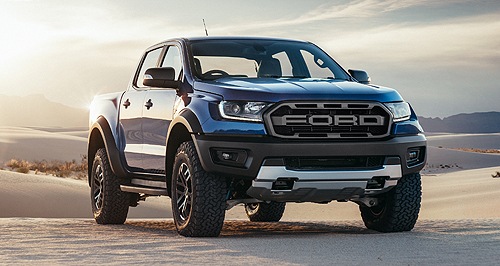News - Ford - Ranger - Raptor
Petrol “not considered for Ford Ranger Raptor”Petrol powerless: Ford insists it was diesel or nothing for the Ranger Raptor, despite much conjecture about twin-turbo V6 petrol engine. Ford Performance targeted twin-turbo two-litre diesel for Ranger Raptor from day one8 Feb 2018 FORD insists that its new Ranger Raptor was never destined to be powered by a petrol engine, despite conjecture to the contrary.
The top-spec dual-cab ute was unveiled to an enthusiastic local crowd in Bangkok, Thailand, this week, with a new 157kW/500Nm EcoBlue bi-turbo 2.0-litre four-cylinder engine linked to a 10-speed transmission confirmed as its only powertrain option.
Ford Performance chief engineer Jamal Hameedi told GoAuto that this engine and transmission combination was the only powertrain considered for the Ranger Raptor.
“The bi-turbo/10-speed,” said Mr Hameedi when asked if any other engines were considered. “There was the bi-turbo/10-speed, and the bi-turbo/10-speed.” When asked if the engineering team considered the 336kW V6 petrol engine fitted to the United States-market F-150 Raptor, Mr Hameedi was adamant that it was never on the table.
“Not from the start. Not once,” he said. “We wanted the best diesel available that we could get our hands on.”
Mr Hameedi responded strongly when it was suggested that potential customers might not consider the 2.0-litre turbo diesel a performance engine.
 Left: Ford Performance chief engineer Jamal Hameedi. Left: Ford Performance chief engineer Jamal Hameedi.
“My response to that is, you don't get what a Raptor is all about,” he said, likening the Ranger Raptor to a desert racing ‘pre-runner’ that scouts long, fast stages ahead of a racing vehicle. “If you're focusing on the engine, you're missing the whole point.”
Mr Hameedi pointed to aftermarket Fox Racing Shox dampers to the Ranger Raptor as an example of the vehicle’s capability.
“The Raptor is about the suspension,” he said. “It's about the chassis. And it's about breaking the bank on the chassis, the suspension, the architecture, the shocks.
“Those four shocks cost as much as a small engine. That's not an exaggeration.
So, that's how much money we have tied up in those.
“And that's what the Raptor is. It's not about horsepower. It's not about torque. It's having enough horsepower and enough torque to do the job, but it's not the focal point.”
Ford Asia Pacific’s vice president of product development Trevor Worthington confirmed Mr Hameedi’s sentiments.
“We look at the overall requirements of who's going to use this vehicle, and then I guess what we do is we look at the Ford Performance DNA and we look at who are customers are currently, and then we pick all the settings that we think are going to deliver the right outcome,” Mr Worthington told journalists.
“We've been waiting for this engine for a while. The combination of the bi-turbo engine and the 10-speed gearbox and the final drive ratio delivers everything that a performance truck customer wants, but delivers it in a way that customers are used to.” Mr Worthington, who is based in Shanghai, pointed to the fact that the Ranger – a number one seller in Thailand, New Zealand, Vietnam and other Asian markets – is known as a diesel vehicle.
“This isn't just about straight-line performance, it is about overall capability,” he said. “And all of those elements that are delivered by that Ranger DNA.”
Mr Hameedi also said that several build elements of the Ranger Raptor far exceeded the ability of aftermarket modifiers to duplicate them, in particular the Ranger’s multiple drive mode functions.
“There's technology aspect that you can't get in the aftermarket,” he said.
“But there's also that content that is in that truck that to duplicate it in the aftermarket would cost you a fortune.”
The EcoBlue engine started life in 2016 as a powerplant for commercial vehicles such as Transit, but Mr Hameedi said that the engine was not necessarily picked because it was the strongest.
“Usually we don't go in looking at durability we engineer durability in,” he said. ‘So if it didn't pass our durability (tests), we would have modified it to get there. So it wasn't really a screening point going into the project.”
The Ranger Raptor marks the first deployment of Ford’s new bi-turbo system in which a small variable geometry turbo combines with a larger, fixed-geometry turbo to flesh out the torque curve across the rev range.
No specific technical figures outside of outputs – 157kW and 500Nm – were offered, but Mr Hameedi acknowledged it was a “challenging” system to construct.
“It's more challenging from a control systems standpoint, because you've got wastegates and bypasses, and when you're using one turbo, you have to keep the other one spooled,” he said. “There's a lot of control system challenges, but it’s not insurmountable.”
Mr Hameedi said the 10-speed automatic transmission – co-developed with General Motors and to be deployed in the 2018 Ford Mustang – did not mean that the demise of dual-clutch gearboxes was imminent.
“It's pretty darn impressive,” he said. “In the context of a Raptor, we mandate a torque converter to dampen all the torsional shock loading, which is something a dual-clutch can’t offer. The torque converter is your friend from a durability standpoint. We're very comfortable with the torque converter in a Raptor. But we like dual clutches, too.” 
Read more
|
Click to share
Ford articles
Ranger pricingWildtrack 4X4 Double Cab Pickup XL 3.2 4X4 Double Cab Chas XL 4X4 Double Cab Chas XL 4X4 Double Cab Pickup XL 4X4 Single Cab Chas XL 4X4 Super Cab Chas XL 4X4 Super Cab Pickup XL Highrider Double Cab Chas XL Highrider Double Cab Pickup XL Highrider Single Cab Chas XL Highrider Super Cab Chas XL Plus 3.2 4X4 Double Cab Chas XL Plus 4X4 Double Cab Pickup XL Plus 4X4 Single Cab Chas XL Single Cab Chas XL Single Cab Pickup XLS 4X4 Double Cab Pickup XLT 4X4 Double Cab Pickup XLT 4X4 Super Cab Pickup XLT Highrider Double Cab Pickup XLT Highrider Super Cab Pickup
Motor industry news GoAutoNews is Australia’s number one automotive industry journal covering the latest news, future and new model releases, market trends, industry personnel movements, and international events. |


 Left: Ford Performance chief engineer Jamal Hameedi.
Left: Ford Performance chief engineer Jamal Hameedi. 










Facebook Twitter Instagram